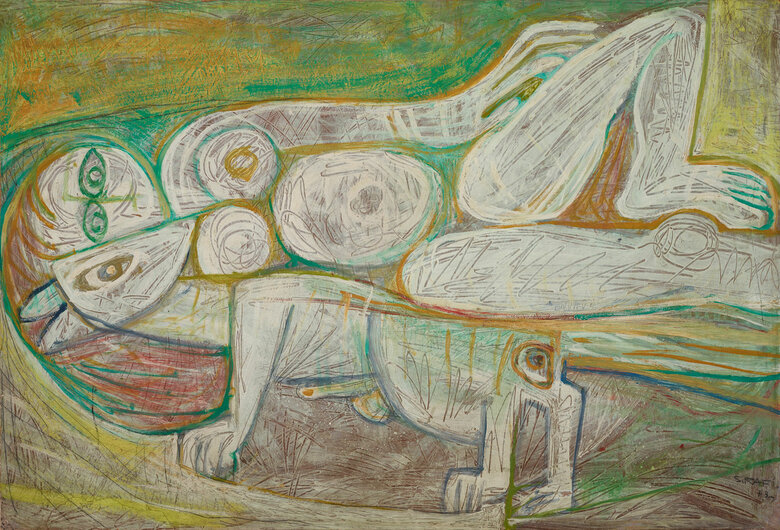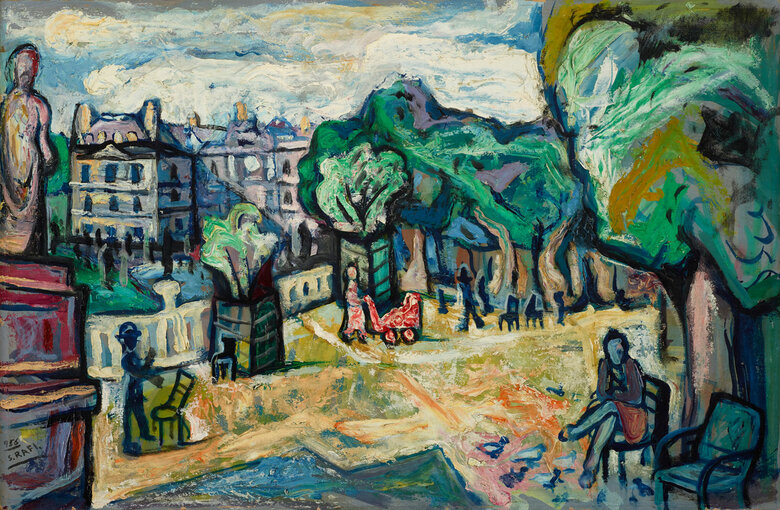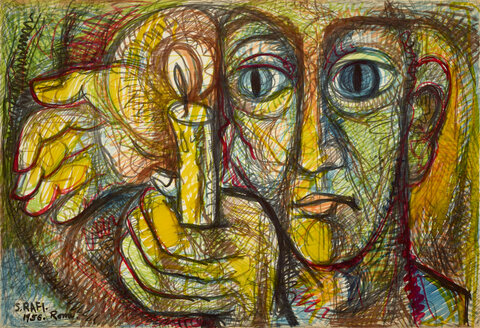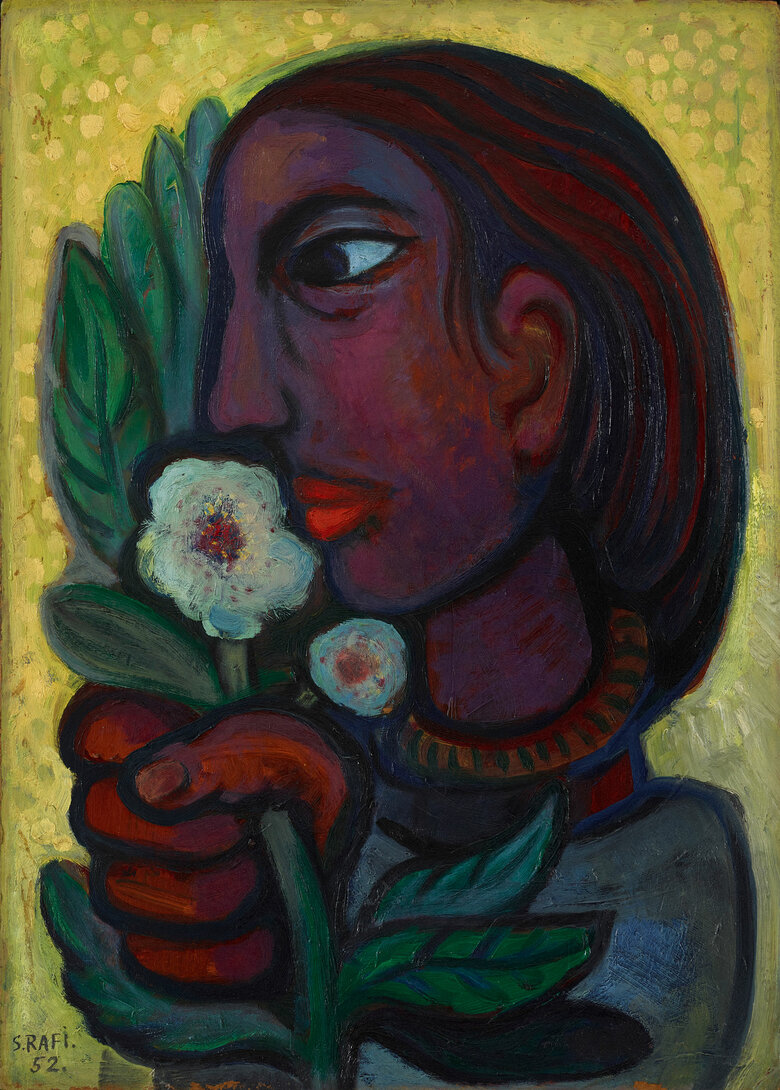Written by Arthur Debsi Born in 1926 in the district of El Sakkakini in Cairo, Samir Rafi came from a wealthy, and multi-confessional family. His father was a Muslim lawyer, and his mother, who...


SAMIR RAFI, Egypt (1926 - 2004)
Bio
Written by Arthur Debsi
Born in 1926 in the district of El Sakkakini in Cairo, Samir Rafi came from a wealthy, and multi-confessional family. His father was a Muslim lawyer, and his mother, who was Christian, taught the young boy French. In 1942, Rafi enrolled in the Farouk Secondary school, and received his first art courses under the supervision of the painter Hussein Youssef Amin (1904-1984). In 1943, he pursued his education at the School of Fine Arts in Cairo, specializing in decorative art, and immediately imposed a personal, and independent style. He effectively showed a sort of distance from the Western academic teaching, which was provided in the institution, as well as appreciated by the Westernized Egyptian elite. This specificity caught the attention of some art educators such as Hussein Bicar (1913-2002), and Maurice Louis Savin (1894-1973), who supported him to continue his dynamic during his student years. For his graduation project, Rafi consequently produced a tapestry with a surrealist inspiration, thanks to which, he received his diploma with honors in 1948. Then, the artist completed his studies at the Higher Institute of Pedagogic Art Studies at Ain Shams University in Cairo, and embarked on a career in teaching. From 1950 to 1954, he held many positions, starting as a drawing teacher at the Tanta Secondary school, and Khalifa al-Ma’moun School, prior to become professor in decorative arts at the Faculty of Fine Arts at Cairo University in 1953. In July 1954, Samir Rafi traveled on a governmental scholarship to France with his wife, and settled in Paris. He studied History of modern art, and museology at the École du Louvre from 1955 to 1958, while pursuing his Ph.D. in art History under the professor André Chastel (1912-1990) at La Sorbonne University. In the French capital city, Rafi used to visit galleries, museums, and was able to encounter important figures from the local, and international artistic scene such as the painters André Lhote (1885-1962), Pablo Picasso (1881-1973), and the architect Le Corbusier (1887-1965). However, he didn’t feel much fulfilled, and decided to travel to Algeria in summer 1964, with a group of Algerian political activists, that he had met before in Paris. Principal leader of the Algerian War of Independence, Ahmed Ben Bella (1916-2012) became the first president of independent Algeria until 1965, and knew Samir Rafi from the time when he took refuge in Cairo in 1949[1]. Rafi established in Algiers, and was appointed technical advisor in fine arts by the Ministry of National Education. Yet, he was sent to jail, accused of spying for the Egyptian president Gamal Abdel Nasser (1918-1970). Released in 1965, he became professor of History of modern art at the Faculty of Letters in Algiers, between 1968 and 1969. He eventually left the country to return to France, where he remained until his death.
In the Farouk Secondary School, Hussein Youssef Amin (1904-1984) noticed the early talent of Samir Rafi. The captivation was such, that he encouraged him to exhibit his works at the Qattan Library in Cairo in 1943, organized by Fouad Kamel (1919-1973) when Rafi was only 17 years old[2].
In the mid-1930s, the ideology from the Nazi, and the Fascist movements, which were occurring in Europe, emerged in Egypt amid social, and political instability[3]. The outbreak of World War II stressed the rise of Fascist, and Nazi ideals, and actions, seen as alternative option to the two Egyptian leading parties: Al-Wafd (The Delegation), opposed to Al-Ittihad (The Union)[4]. Initiated by the Egyptian poet Georges Henein (1914-1973) in 1938 in Cairo, Art and Liberty was a cultural movement, which brought together writers, and artists such as Kamel El-Telmisani (1923-1987), Mayo (1905-1990), and Ramses Younan (1913-1966). Faced with the growing threat of Fascism, the group specifically stood for freedom, and rejected any form of cultural alienation, and political propaganda. The artists chose Surrealism to express their art, to capture the concerns of the society upon the eve of the war. In their productions, they vividly brought out the themes about fear, anguish, and poverty, as a call for a social, and political revolution[5]. When the movement was developing, Samir Rafi was still a student, but he did join the group, and worked with the artists at the Maison des artistes in Darb al-Labbana in Cairo.
Although he was undoubtedly influenced by his mentors, and participated in some exhibitions of the Art and Liberty group, Rafi didn’t categorically reveal himself as a surrealist artist. He aimed to propose an artistic language, which would pave the road to another Egyptian modern art movement. In 1946, he effectively co-founded the Contemporary Art Group (Jama’at al-Fann al-Mu’asir), alongside Abdel Hadi El-Gazzar (1925-1966), and Hamed Nada (1924-1990) to name a few. These artists somehow concluded that Art and Liberty could be associated to an elitist movement, and tinted with Western aspirations, by the audience[6]. Unlike the nationalist ideology, that was spread by the movement of al-Nahda (the Awakening) in Egypt from the second half of the 19th century, for example through the works of Mahmoud Mokhtar (1891-1934); the position of the Contemporary Art Group was more against colonial art. Thus, it moved towards a creation, and style, which was more related to the representation of local matters[7].
The oeuvre of Samir Rafi certainly presents a style, inherited from Art and Liberty, in the sense that the artist always remained free from academic conventions. As of the late 1940s, however, it is important to note that his artistic program tended to ‘Egyptianize’ Surrealism, which meant to integrate a local authenticity to the artworks. This program also included a better understanding of the Egyptian identity, through the living environment of its people, and its culture. Part of the Dalloul Art Foundation’s collection, Femme à la Fleur (1952) demonstrates the importance of Samir Rafi to shed light on ordinary, and underprivileged people in his artworks. Here, he portrayed a woman in profile, who is wearing a necklace, and smelling a white flower. The subject of the painting is simple, but the treatment, that the painter employed, is completely outstanding. Rafi used a warm palette of colors in an original manner, coloring the skin of the woman with red and blue. In parallel, he detached the character from the reality, and exaggerated the different parts of the body, such as the ear, and the hand. This peculiar treatment conveys a mystic atmosphere, in which the woman is surrounded by a yellow-gold halo. Mysticism, superstations, and magic rituals occupy a significant place in the works of Samir Rafi, and more broadly in the ones of the artists from the Contemporary Art Group. As a matter of fact, these traditional practices, and beliefs, are firmly rooted in the Egyptian folk life, and culture. In Visage d’homme à la bougie (1956), also part of the DAF’s collection, he depicted a man with wide, and almond-shaped eyes. The character is captivated, almost mesmerized by the light of the candle, that he is holding with his left-hand. The painter revealed another facet of the society, non-bourgeois, or Westernized, which is another illustration of the modern era in Egypt.
The Egyptian uniqueness has always been a major theme, which characterizes the art of Samir Rafi, and became more visible during his lifetime in Paris. When he completed his education at the École du Louvre, Rafi broaden his knowledge on Egyptian ancient art, and produced several works, which highly refer to the wall paintings on the temple, and tombs from the Pharaonic times[8]. In the imposing work entitled Momie Ressuscitée (1959), in the Dalloul Art Foundation’s collection, he recalled the visuals of Egyptian ancient art, through thick black lines, lack of perspective, and the use of earthy colors, like beige, and orange. Nevertheless, the portrait also showed the mastery of the artist in modern European techniques, by synthesizing the body features to simple, and abstracted forms. In the first decade of the 20th century, some European artists from the Cubist movement, like Georges Braque (1882-1963) started working on various media, such as papier collés, or raw materials, within the same composition. Here, Samir Rafi used the jute, which the rough appearance, and common use, recall the working-class. Hence, by illustrating a noble subject from the great Egyptian past on a cheap material, the artist indicated that the guarantee of the cultural heritage, is ensured by the common people.
A prominent figure of the modern art movements from the 20th century in Egypt, Samir Rafi succeeded in interpreting the Egyptian cultural, and artistic language, to tackle the multiple matters of his time. Through a symbolic painting, he delved into the past, and resurrected it in the present in order to portray the Egyptian modern society.
Samir Rafi passed away in 2004 in Paris.
Notes:
[1] Mostafa Kanafani, Fatenn. Uncensored Samir Rafi, [Exhibition Catalogue, ‘Uncensored Samir Rafi’. Cairo, ArtTalks Egypt, September 24th 2019 – November 5th 2019]. Cairo, Egypt: ArtTalks Egypt, 2019.
[2] Mostafa Kanafani, Fatenn. Uncensored Samir Rafi, [Exhibition Catalogue, ‘Uncensored Samir Rafi’. Cairo, ArtTalks Egypt, September 24th 2019 – November 5th 2019]. Cairo, Egypt: ArtTalks Egypt, 2019.
[3] Achcar, Gilbert. ‘Confronting Fascism in Egypt: Dictatorship versus Democracy in the 1930s’, The Arab Studies Journal 20, no. 1 (2012): 162-66. Accessed September 10, 2020. http://www.jstor.org/stable/23265841. [P.162]
[4] Bardaouil, Sam, and Fellrath, Till. Art Et Liberté, Rupture, War and Surrealism in Egypt (1938-1948), [Exhibition Catalogue, ‘Art Et Liberté, Rupture, Guerre Et Surréalisme En Égypte (1938-1948)’. Paris, Centre Georges Pompidou, October 19th 2016 – January 16th 2017]. Paris, France: Skira, 2016. [P.28]
[5] Bardaouil, Sam, and Fellrath, Till. Art Et Liberté, Rupture, War and Surrealism in Egypt (1938-1948), [Exhibition Catalogue, ‘Art Et Liberté, Rupture, Guerre Et Surréalisme En Égypte (1938-1948)’. Paris, Centre Georges Pompidou, October 19th 2016 – January 16th 2017]. Paris, France: Skira, 2016. [P.28]
[6] Mostafa Kanafani, Fatenn. Uncensored Samir Rafi, [Exhibition Catalogue, ‘Uncensored Samir Rafi’. Cairo, ArtTalks Egypt, September 24th 2019 – November 5th 2019]. Cairo, Egypt: ArtTalks Egypt, 2019.
[7] Seggerman, Alex Dika. Modernism on the Nile: Art in Egypt between the Islamic and the Contemporary. Chapel Hill, USA: University of North Carolina Press, 2019. [P.166]
[8] Mostafa Kanafani, Fatenn. Uncensored Samir Rafi, [Exhibition Catalogue, ‘Uncensored Samir Rafi’. Cairo, ArtTalks Egypt, September 24th 2019 – November 5th 2019]. Cairo, Egypt: ArtTalks Egypt, 2019.
Sources:
Achcar, Gilbert. ‘Confronting Fascism in Egypt: Dictatorship versus Democracy in the 1930s’, The Arab Studies Journal 20, no. 1 (2012): 162-66. Accessed September 10, 2020. www.jstor.org/stable.
Bardaouil, Sam, and Fellrath, Till. Art Et Liberté, Rupture, War and Surrealism in Egypt (1938-1948),[Exhibition Catalogue, ‘Art Et Liberté, Rupture, Guerre Et Surréalisme En Égypte (1938-1948)’. Paris, Centre Georges Pompidou, October 19th 2016 – January 16th 2017]. Paris, France: Skira, 2016.
Eigner, Saeb. Art of the Middle-East, Modern and Contemporary Art of the Arab World and Iran. London, UK: Merell Publishers Limited, 2011.
Gronlund, Melissa. “Spotlight on Samir Rafi: A Conundrum among the Canon of Modern Arab Art Comes to Dubai,” January 30, 2019. www.thenational.ae/arts-culture/art
Kane, Patrick. "Art Education and the Emergence of Radical Art Movements in Egypt: The Surrealists and the Contemporary Arts Group, 1938-1951." The Journal of Aesthetic Education 44, no. 4 (2010): 95-119. Accessed September 10, 2020. www.jstor.org/stable/
Karnouk, Liliane. Modern Egyptian Art, 1920-2003. Cairo, New York, Egypt, USA: The American University in Cairo Press, 2005.
Lenssen, Anneka, A. Rogers, Sarah, and Shabout, Nada. Modern Art in the Arab World, Primary Documents. New York, USA: The Museum of Modern Art, 2018.
Merle, Robert. “Ahmed Ben Bella,” April 24, 2020. www.britannica.com
Mostafa Kanafani, Fatenn. “The Island of Hope, How the Art and Liberty Group Sought to Save Egypt from Itself,” 2016. rawi-magazine.com
Mostafa Kanafani, Fatenn. “The Permanent Revolution: From Cairo to Paris with the Egyptian Surrealists Two Independent Exhibitions Commemorate an Important Chapter of Egyptian Modernism,” 2016. www.madamasr.com
Mostafa Kanafani, Fatenn. Uncensored Samir Rafi, [Exhibition Catalogue, ‘Uncensored Samir Rafi’. Cairo, ArtTalks Egypt, September 24th 2019 – November 5th 2019]. Cairo, Egypt: ArtTalks Egypt, 2019.
Seggerman, Alex Dika. Modernism on the Nile: Art in Egypt between the Islamic and the Contemporary. Chapel Hill, USA: University of North Carolina Press, 2019.
CV
Selected Solo Exhibitions
2019
Samir Rafi Uncensored, ArtTalks Egypt, Cairo, Egypt
Spotlight: Samir Rafi, Green Art Gallery, Dubai, United Arab Emirates
Samir Rafi, Ubuntu Art Gallery, Cairo, Egypt
2005
Samir Rafi: Masterpieces on show for the first time in 50 years, Palace of Arts, Gezira, Cairo, Egypt
1970
Samir Rafi, 1945-1969, Louveciennes for Arts and Culture, Mairie de Louveciennes, France
1944
Smith Bookstore, Cairo, Egypt
1943
Qattan Library, Cairo, Egypt
Selected Group Exhibitions
2024
Arab Presences: Modern Art And Decolonisation: Paris 1908-1988, Musée d'Art Moderne de Paris, Paris, France
The Collector´s Eye XI, Ubuntu Art Gallery, Cairo, Egypt
2023
Crossroads: A Collector’s Tale, Picasso Art Gallery, Cairo, Egypt
The Little Prince of Gaza, Dalloul Art Foundation, Beirut, Lebanon
2022
Taking Shape: Abstraction from the Arab World, 1950-1980s, Herbert F. Johnson Museum, Cornell University, Ithaca, United States
Taking Shape: Abstraction from the Arab World, 1950-1980s, Block Museum of Art of Northwestern University, Evanston, United States
Surrealism Beyond Borders, Tate Modern, London, United Kingdom
Contemporary Views, Almasar Gallery, Cairo, Egypt
2021
Monaco-Alexandrie, le grand detour. Villes-Mondes et surréalisme cosmopolite, NMNM – Villa Sauber, Monaco, France
Surrealism Beyond Borders, The Metropolitan Museum of Art, New York, United States
Taking Shape: Abstraction from the Arab World, 1950-1980s, Tampa Museum of Art, Tampa, United States
Taking Shape: Abstraction from the Arab World, 1950-1980s, McMullen Museum of Art at Boston College, Boston, United States
Contemporary Views XIV, Al-Masar Gallery, Cairo, Egypt
2020
Taking Shape: Abstraction from the Arab World, 1950-1980s, Grey Art Gallery, New York University, New York, United States
2018
A Century in Flux, Highlights from the Barjeel Art Foundation, Sharjah Art Museum, Sharjah, United Arab Emirates
Art et Liberté, Rupture, War and Surrealism in Egypt (1938-1948), Moderna Museet, Stockholm, Sweden
Art et Liberté, Rupture, War and Surrealism in Egypt (1938-1948), Tate Liverpool, Liverpool, United Kingdom
2017
Modern Art from the Middle East, Yale University Art Gallery, New Haven, United States of America
Art et Liberté, Rupture, War and Surrealism in Egypt (1938-1948), Kunstsammlung Nordrhein-Westfalen,Düsseldorf,Germany
Art et Liberté, Rupture, War and Surrealism in Egypt (1938-1948), Museo Nacional Centro de Arte Reina Sofia, Madrid, Spain
2016
Art et Liberté, Rupture, guerre et surréalisme en Égypte (1938-1948), Centre Pompidou, Paris, France
The Contemporary Art Group (1946), Al-Masar Gallery, Cairo, Egypt
The Short Century, Sharjah Museum, Sharjah, United Arab Emirates
2015
Aide-Mémoire, Footnotes (Part II), Barjeel Art Foundation, Sharjah, United Arab Emirates
2013
Re: Orient, Barjeel Art Foundation, Sharjah, United Arab Emirates
1987
Retrospective of the group of Art et Liberté, Egyptian Center for International Culture, Zamalek, Cairo, Egypt
1968
Centre Culturel Français, Algiers, Algeria
1961
Salon d’Automne, L’Art pour Tous gallery, Cairo, Egypt
1954
The 27th Venice Biennial, Venice, Italy
Le Groupe de l’Art Contemporain, André Maurice Gallery, Paris, France
1953
The 2nd São Paulo Biennial, São Paulo, Brazil
Fourth exhibition of the Contemporary Art Group, Modern Egyptian Art, Cairo, Egypt
1952
The 26th Venice Biennial, Venice, Ital
1951
Third exhibition of the Contemporary Art Group, Bureau des Avocats, Cairo, Egypt
1949
Égypte-France, Musée des Arts Décoratifs, Pavilon Marsan, Paris, France
Second exhibition of the Contemporary Art Group, Foyer d’Art du Lycée Français, Cairo, Egypt
1948
Exposition de l’Art Contemporain, Service de la Jeunesse, Cairo, Egypt
1947
International Exhibition, Cairo, Egypt
1946
First exhibition of the Contemporary Art Group, Foyer d’Art du Lycée Français, Cairo, Egypt
1945
Vème Exposition de l’Art Indépendant, Foyer d’art du Lycée Français, Cairo, Egypt
Awards and Honors
1947
Honorary Prize of Young Painting
1943
Gold Medal by Ministry of Public Instruction. Best drawing student nationwide.
Affiliations and Memberships
1946
The Contemporary Art Group
Collections
May Moein Zeid & Adel Youssry Khedr collection, Cairo, Egypt
The Museum of Fine Arts, Alexandria, Egypt
The Barjeel Art Foundation, Sharjah, United Arab Emirates
The Museum of Modern Egyptian Art, Cairo, Egypt
The Ramzi and Saeda Dalloul Art Foundation, Beirut, Lebanon
Press
“There is Egyptian genuineness in this talented painter” Pablo Picasso (In a letter to Gino Severini). By Omar Al Busaidy National Pavilion United Arab Emirates.pdf
Samir Rafi Exhibition at Picasso Gallery Cairo 360 Guide to Cairo, Egypt.pdf
raseef22_com.pdf
Portrait of the artist as a strange man - Al Ahram Weekly.pdf
The permanent revolution_ From Cairo to Paris with the Egyptian surrealists MadaMasr.pdf
SAMIR RAFI Artwork
Become a Member
Join us in our endless discovery of modern and contemporary Arab art
Become a Member
Get updates from DAF
Follow Artists
Save your favourite Artworks
Share your perspectives on Artworks
Be part of our community
It's Free!
We value your privacy
TermsCookiesPrivacy Policies
Become a Member
Get updates from DAF
Follow Artists
Save your favourite Artworks
Share your perspectives on Artworks
Be part of our community
It's Free!
We value your privacy
TermsCookiesPrivacy Policies
Become a Member
Get updates from DAF
Follow Artists
Save your favourite Artworks
Share your perspectives on Artworks
Be part of our community
It's Free!
We value your privacy
TermsCookiesPrivacy Policies
Welcome to the Dalloul Art Foundation
Thank you for joining our community
If you have entered your email to become a member of the Dalloul Art Foundation, please click the button below to confirm your email and agree to our Terms, Cookie & Privacy policies.
We value your privacy, see how
Become a Member
Get updates from DAF
Follow Artists
Save your favourite Artworks
Share your perspectives on Artworks
Be part of our community
It's Free!
We value your privacy
TermsCookiesPrivacy Policies

-Front.jpg)
-Front.jpg)
_SamirRafi_Front.jpg)









